Cucumbers are parasitized by 2 types of pathogenic fungi that cause diseases with a similar name. Both diseases are extremely harmful and more often affect greenhouse cucumbers than ground cucumbers. Powdery mildew sometimes appears in open ground, but downy mildew rarely occurs outdoors.
Similarities and differences between diseases
Despite the similar names of the diseases, the pathogens, symptoms and drugs against them are different.
| Signs | Powdery mildew | Downy mildew |
| Pathogen | Oidium mushroom | Peronospora fungus |
| Mycelium | From the top side of the leaves | On the underside of the leaves |
| Manifestations | White powdery coating | On the underside there is a white-violet coating, on the top there are yellow oily spots |
| What amazes | Mostly greenhouse cucumbers | It spreads most strongly in greenhouses. Less common in open ground |
| Favorable conditions | Sudden changes in day and night temperatures | Rainy and cold summer |
| Distributed by | With soil, water, plant residues. During the period of sporulation, spores are carried by the wind | With plant residues, water, contaminated seeds |
Medicines for treating diseases are also different.
Powdery mildew (ashtray)
This is probably the most common disease of greenhouse cucumbers. In protected ground it spreads instantly and its harmfulness is enormous. In open ground, powdery mildew is less common, does not spread as rapidly, and treatment measures have a much greater effect than in a greenhouse.
Description of the pathogen.
- Powdery mildew on cucumbers is caused by pathogenic oidium fungi. Several strains of this pathogen can parasitize cucurbits.
- The pathogen overwinters in the soil and on plant debris, where it can persist for up to 5-7 years.
- It affects cucumbers starting from the germination phase. Infection can occur throughout the growing season, but most often occurs in the second half of summer.
- Distributed with soil and water. During the sporulation period, spores can be carried by the wind.
Conditions for the occurrence of the disease
Favorable factors for the development of the disease on cucumbers are strong temperature changes - more than 10°C. High humidity promotes the spread of powdery mildew. It spreads most strongly in damp summers. Even if the weather is hot, but rainy, with high humidity, powdery mildew still affects the plants, although not as much as in a cold and damp summer. The first outbreaks appear:
- in the greenhouse - near doors, windows, film breaks;
- outside - in the wettest places of borage. Most often, lesions appear a few days after heavy rainfall;
- Thickened plantings, both in open and protected ground, are the first to be affected by powdery mildew.
The incubation period lasts 3-5 days, when cucumbers are already infected, but there are no signs of the disease yet.
Signs of powdery mildew damage to cucumbers
- Leaves, petioles and stems of cucumbers are affected.
- Spots of white powdery coating appear on the leaves on the upper side, which are initially easily erased from the surface. But after a few hours they appear again.
- The spots gradually merge with each other, the edges of the leaves bend slightly downwards and dry out.
- Severely affected leaves become wavy, dry out and fall off.
- When powdery mildew spreads widely, the stems are affected. Pads of white fluffy plaque appear on them, but not as thick as with white rot. The scourges begin to dry.
Zelentsy do not suffer from powdery mildew, but yields when affected by the pathogen are reduced by 40-50%. The greens themselves become small and bitter.
Fighting the disease with chemicals
Treatment is carried out immediately when the first signs are detected.It should be taken into account that infection of healthy plants occurs rapidly, and the slightest delay can lead to crop failure and plant death.
- Colloidal sulfur, the main drug against powdery mildew, is not used in the greenhouse. In a greenhouse, where there is high temperature and humidity, even a normal concentration of the drug can cause severe burns to cucumbers, and if the concentration is exceeded, even slightly, the plants can be destroyed. In open ground, treatment with sulfur preparations is best done in cloudy weather. Prepare the working solution strictly according to the instructions. When treating with sulfur and its derivatives, the air temperature should be no less than 20°C and no more than 32°C. At low temperatures, the drugs will not work; at high temperatures they are phytotoxic, that is, they kill plants. Colloidal sulfur is sold in pure form in garden stores; a preparation based on it is Tiovit Jet. All pumpkin crops and cucumber, in particular, are very sensitive to sulfur, so they carry out a single treatment. It is impossible to spray cucumbers with sulfur-containing preparations several times during the growing season.
- Application of fungicides: Rayok, Tilt, Topsin-M, Topaz, Bayleton. Repeated treatment is carried out after 14 days, changing the drug, since the pathogen very quickly becomes resistant to the drugs.
- At an early stage, the biological product Alirin B is used. The soil bacteria contained in it at a very early stage are capable of destroying the pathogen. It is usually used if there is a high risk of developing the disease. Treatment is carried out 2-3 days after heavy rains.
Folk remedies
Used for the prevention and treatment of the initial stage of the disease.
- When the first signs appear or when there are sharp fluctuations in day and night temperatures, cucumbers are treated with an alcohol solution of iodine (sold in pharmacies). Iodine solution contains alcohol and iodine. Iodine is an antiseptic and causes the death of pathogenic microflora; alcohol is also an antiseptic; it suppresses the development of the pathogen, although it does not kill it. 10 ml of 5% iodine solution is diluted in 10 liters of water.
- Spraying cucumbers with a strong raspberry solution of potassium permanganate. It is a strong disinfectant and prevents the penetration of the pathogen into plant tissue, and at the initial stage it kills germinating fungal spores.
- Preventive treatment of cucumbers with kefir (1 l/10 l of water). Lactic acid bacteria are antagonists of pathogenic microflora and prevent their growth and spread.
- Using soda ash. The drug has a strong alkaline reaction, which parasitic fungi cannot tolerate. Preparation of the working solution: 50 g of soda ash is diluted in 10 liters of water, and 40 g of soap is added as an adhesive. The treatment is carried out with a freshly prepared solution. Sick plants are treated once every 7 days in cloudy weather. To prevent powdery mildew, cucumbers are sprayed 2-3 times during the growing season.
With any treatment method, all affected leaves must be removed.
Disease prevention
- If powdery mildew appears in the greenhouse from year to year, then remove a layer of soil of at least 10 cm, replacing it with a new one.
- In autumn, all plant debris is removed.
- The greenhouse is disinfected by lighting sulfur bombs in it, or the structures are washed using disinfectants.
- Thinning thickened crops, since this is where the first foci of the disease most often appear.
- Thorough ventilation of greenhouses. Reducing humidity also reduces the risk of powdery mildew.
- Removing weeds around the borage perimeter.
Varieties resistant to powdery mildew
Currently, a sufficient number of them have been bred, both hybrids and bee-pollinated varieties. Resistance means that even if the pathogen spreads slightly, cucumbers are not affected. During a severe outbreak of the disease, only individual leaves on the cucumber are affected, but the majority of cucumbers are not sick.
| Hybrids resistant to powdery mildew | |
|
|
| Varietal bee-pollinated cucumbers with disease resistance | |
|
|
Downy mildew (peronospora)
A disease similar to the previous one only in name. There is little in common between MR and LMR. It most often affects greenhouse cucumbers. In open ground it is less common than MR. It does not spread as quickly as the real one if the pathogen is on plant debris. If the seeds are infected, then the entire borage may die in a few days.
Description of the pathogen
- The disease is caused by the pathogenic fungus peronospora. There are several types of downy mildew fungi that cause plant diseases.
- Overwinters on plant debris and damaged seeds.
- The parasite is very resistant to unfavorable factors and persists in the soil for 6-8 years.
- Distributed with plant debris, soil and water.
- The incubation period is 3 days.
- Spores germinate in the presence of dripping moisture.
Conditions for the appearance of the disease
Downy mildew appears in cold, damp summers. In greenhouses where cucumbers are grown for several years in a row, it is possible that they may appear in hot summers, but this happens much less frequently. More often affects greenhouse cucumbers, ground ones suffer less from it.
The peak of plant incidence occurs in early to mid-July, although it may appear earlier. In the southern regions, when cucumbers are grown in greenhouses, it appears on plants even in winter. Appears 1-2 days after heavy cold dew or rain, as well as when watered with cold water.
Signs of defeat
It only affects leaves and petioles. The first signs appear in the morning. The disease begins with the young upper leaves. The lower leaves are the last to be affected.
- Oily yellow spots appear on the upper side of the leaf, which then merge.
- White-violet areas appear on the lower side - this is a mycelium.
- After 5-7 days, the spots turn brown and the leaf dries out.
- In the absence of protective measures, the entire greenhouse may die in a few days.
The harmfulness of downy mildew is much greater than that of real powdery mildew. If untimely measures are taken, you may be left without a harvest.
If the first signs appear on individual leaves, then the pathogen has entered the cucumbers from the outside. If spots appear on all plants at the same time under unfavorable conditions, it means the seeds have been infected.
Control measures
Measures should be taken in advance, 1-2 days after the rains. And in the greenhouse, cucumbers must be treated preventively.
- Bordeaux mixture is ineffective in the fight against MMR.
- When the first signs of the disease appear, they immediately begin to treat with fungicides. No folk remedies will help. The drugs Strobi and Quadris are used. Treatment is done 2 times per season. The first after rains or heavy cold dew, the second at the first signs of the disease. More than 2 treatments cannot be carried out, since the pathogen very quickly develops resistance to the active substance.
- At the first signs, treat cucumbers with copper-containing preparations; except for those containing copper sulfate, this substance has no effect on peronospora. Usually they use HOM, Ordan, Abiga-Pik.
- Use of drugs Consento, Revus, Previkur.
- All seeds must be treated before planting. Even if they have been treated, it is recommended to treat them again, since the protective effect of the fungicide has already ceased by the time of sowing. At home, seeds are soaked in a strong solution of potassium permanganate for 20-30 minutes. You can use the drug Maxim or biological products Trichodermin, Gamair.
- Removing diseased leaves, they are cut off without leaving stumps. After removal, the cucumbers are sprayed with Trichodermin solution.
- Treatment with Planriz in the initial stage of LMR.
- Thorough ventilation of the greenhouse. It is undesirable to allow droplets of moisture to be released from the leaves in the morning. To do this, the greenhouse is left open overnight.
When signs of the disease appear, at least 3 treatments are carried out with an interval of 3-5 days. The drug is changed every time. Cucumbers can be treated with one preparation no more than 2 times per season, but not in a row, but alternating it with other chemicals. If the substance is effective, then after the first treatment the spots lose their oily tint, dry out, and sporulation stops.
When using LMR, spraying is carried out on the underside of the leaves, since this is where the mycelium develops and spores ripen. The spots on the upper side are simply manifestations of the disease; there are no mycelium or spores on top.
Folk methods of struggle
Traditional methods are mainly preventive.
- Using soda ash. Having a strong alkaline reaction, the chemical prevents the development of the pathogen. Preparation of the working solution: 25-30 g of the drug is diluted in 5 liters of hot water, add 20-25 g of solid or 5 g of liquid tar soap. Treatment is carried out in the first half of the day on the underside of the leaves.
- Spraying cucumbers with a strong solution of potassium permanganate.
Folk remedies are used in places where the disease is expected to develop. If the first signs appear, especially if they appear simultaneously on all plants (which indicates infected seeds), they immediately move on to chemical protection.
Disease prevention
- Before sowing, all cucumber seeds are treated.
- If there were outbreaks of downy mildew in the greenhouse last year, replace the soil to a depth of 10 cm.
- Complete removal of plant residues.
- Disinfection of greenhouses means or setting fire to sulfur bombs. In a greenhouse where outbreaks of downy mildew have been observed, sulfur bombs are set on fire both in the fall and in the spring.
- When watering cucumbers, it is undesirable for water to get on the leaves.
- Preventive treatment with the biological product Gamair.
Prevention, unless the infection is in the seeds, is quite effective and can reduce the risk of downy mildew by 1.5-2 times.
Varieties and hybrids resistant to disease
There are quite a lot of both hybrids and varieties resistant to downy mildew.
| Hybrids resistant to downy mildew | |
|
|
| Resistant bee-pollinated varieties | |
|
|
| Varieties and hybrids with complex resistance to both diseases | |
|
|
You might be interested in:
- What to do if the leaves on the cucumbers begin to turn yellow
- Rot on cucumbers and methods of treating them
- How to effectively fight spider mites
- Features of growing cucumbers in open ground
- What to do if the ovary of cucumbers turns yellow
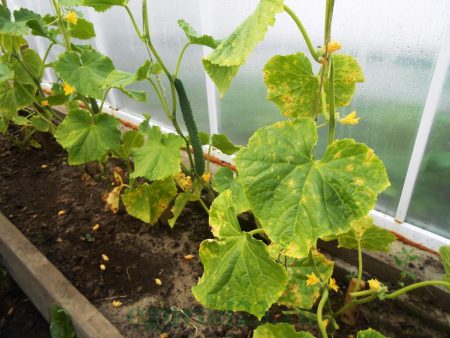
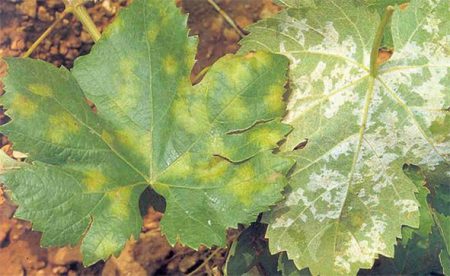
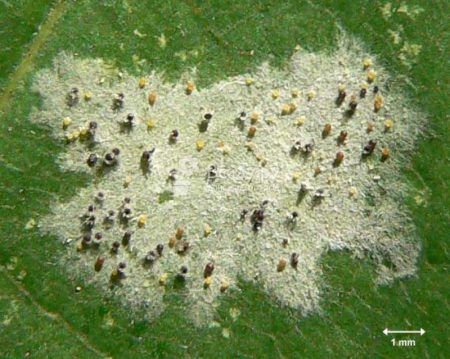
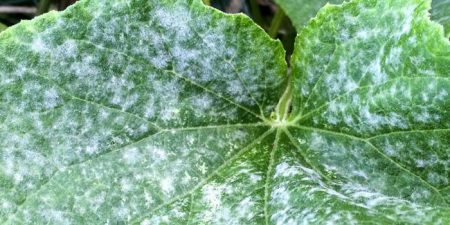

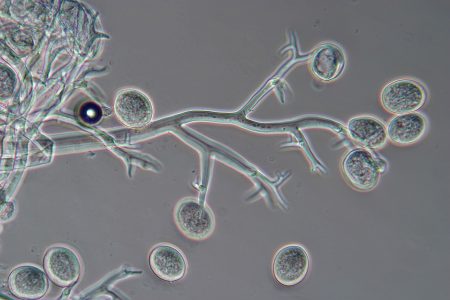
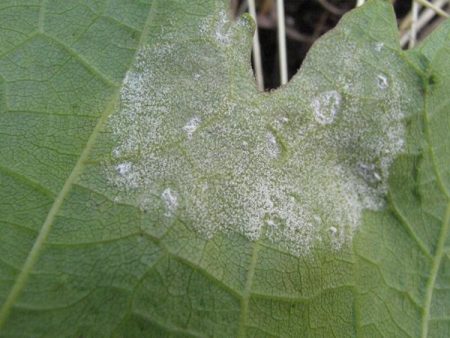
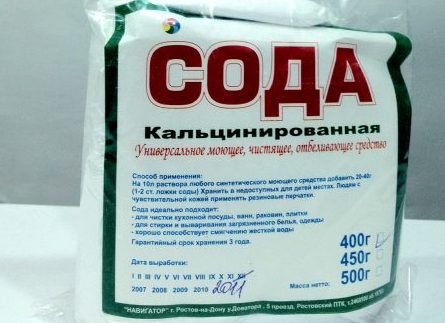

 CUCUMBERS NEVER GET SICK, I'VE BEEN USING ONLY THIS FOR 40 YEARS! I SHARE A SECRET WITH YOU, CUCUMBERS ARE LIKE THE PICTURE!
CUCUMBERS NEVER GET SICK, I'VE BEEN USING ONLY THIS FOR 40 YEARS! I SHARE A SECRET WITH YOU, CUCUMBERS ARE LIKE THE PICTURE! You can dig a bucket of potatoes from each bush. Do you think these are fairy tales? Watch the video
You can dig a bucket of potatoes from each bush. Do you think these are fairy tales? Watch the video
 How our fellow gardeners work in Korea. There is a lot to learn and just fun to watch.
How our fellow gardeners work in Korea. There is a lot to learn and just fun to watch. Eye trainer. The author claims that with daily viewing, vision is restored. They don't charge money for views.
Eye trainer. The author claims that with daily viewing, vision is restored. They don't charge money for views. A 3-ingredient cake recipe in 30 minutes is better than Napoleon. Simple and very tasty.
A 3-ingredient cake recipe in 30 minutes is better than Napoleon. Simple and very tasty. Therapeutic exercises for cervical osteochondrosis. A complete set of exercises.
Therapeutic exercises for cervical osteochondrosis. A complete set of exercises. Which indoor plants match your zodiac sign?
Which indoor plants match your zodiac sign? What about them? Excursion to German dachas.
What about them? Excursion to German dachas.